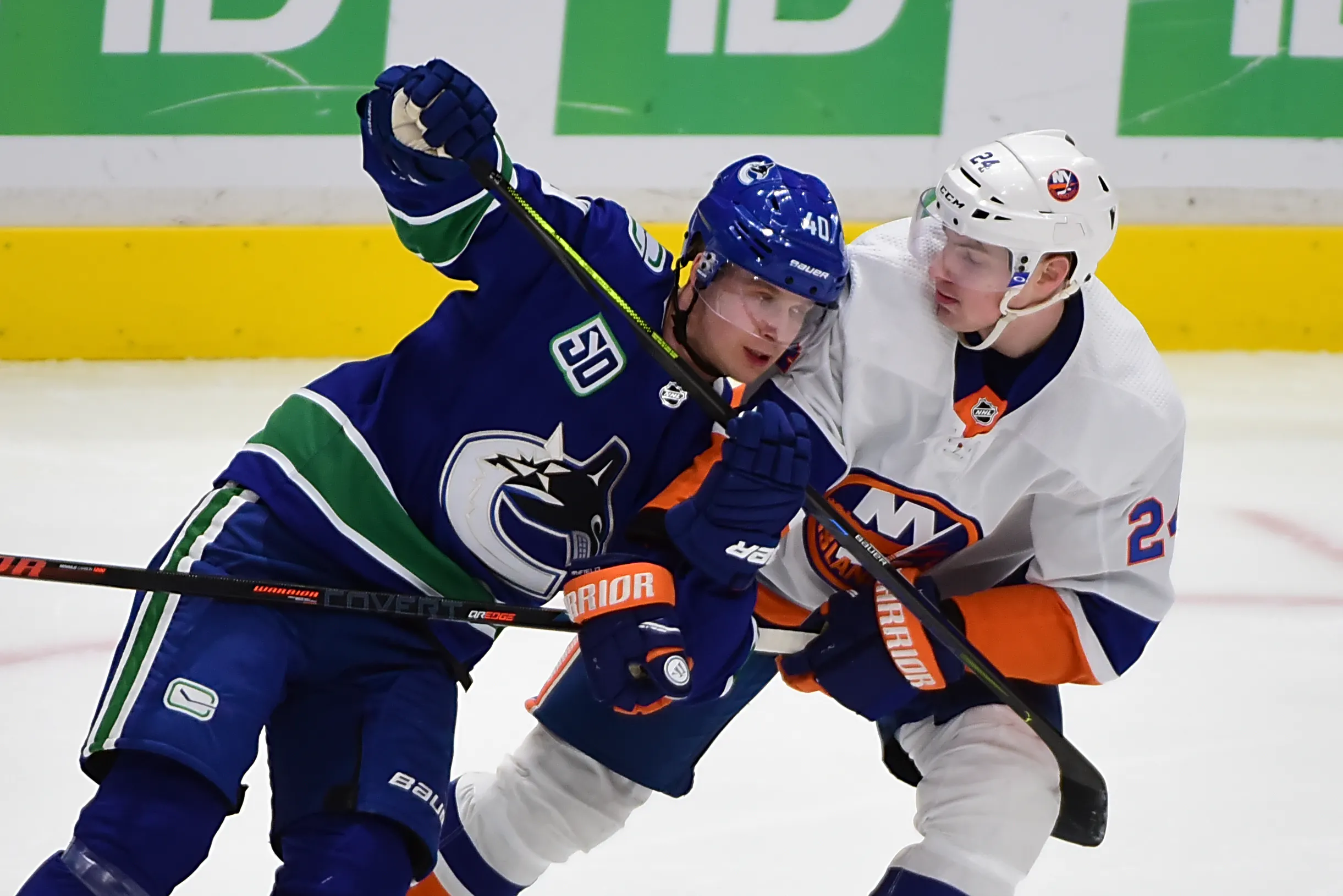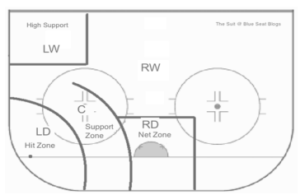The Tape: Is Elias Pettersson Ready to Matchup Against Top Lines? (Part 1)

By Brett Lee
4 years agoWhat can you say about Elias Pettersson that hasn’t already been said?
From the moment he played his first NHL shift and scored his first goal, he altered the trajectory of a franchise and captivated an entire city, dazzling fans with his out of this world skill en route to winning the Calder Trophy. Amidst his record-setting point production, a sizeable chunk of the Vancouver market took notice of the fact that his play without the puck was nearly as impressive as his offensive talent. For every one-timer, there was a tireless backcheck; for every deke, a takeaway or blocked pass. Those who have watched him have come to appreciate what he does for the Vancouver Canucks on the defensive side of the game.
With the Vancouver Canucks clinging on to a Wild Card position, the time has come to wonder if Elias Pettersson’s game is ready to match up against opposing teams’ top-lines. In March, you’re best players need to be your best players and that often means having them play against the best and taking care of the puck in the defensive zone.
First Forward Back
Defensive prowess can, at first, be hard to acknowledge, as it’s often the play away from the action that constitutes responsible defensive play. Plays like the one below where Pettersson dives for pucks to halt dangerous passes stand out as heroic defensive plays but are only one aspect of what makes the Swedish star a two-way dynamo.

Elias Pettersson rarely takes a night off defensively. Regardless of the bounces that come his way in the offensive zone, his commitment and effort to take care of the puck in his own zone is commendable. Due to his work ethic on the backcheck, Pettersson plays the role of a responsible centre as he is usually the first forward back in his own zone unless he was the deep forward in the offensive end. This identification is important within defensive systems today as teams have moved away from the traditional centre and winger defensive responsibilities.
Not too long ago, responsibilities for forwards in the defensive zone would be assigned by position. Wingers would stay high and cover the trailers/defencemen while the centre should be the first forward back to cover the slot and the third high attacking forward. While this is still the case today as that coverage is fundamental to most defences, the assigning of roles have become more fluid. Rather than the centre of a line stay rigid in their duties, teams are now entrusting defensive coverage by order of how a play develops to account for the faster pace of today’s game.
Enter the F1, F2, F3 system where instead of a centre, right-wing, and left-wing, forwards are viewed as the order in which they enter a play. In a defensive scheme, the F1 (ie. the first forward to track back into the defensive zone) would assume the role of the traditional centre, providing support down-low for the defence and covering the third high forward in the lower slot. If we refer to the diagram below, the ‘C’ marks where the F1’s responsibilities would be if the puck were in the left-wing corner. If any loose puck were to spring out, it would be their job to jump on them or take the forward one-on-one if the ‘LD’ is beaten. F2 is where the ‘RW’ is placed and their job is to take away the high-slot and cover the weak-side defenceman from receiving any passes. F3 is the ‘LW’ and as the last man to enter the zone, their job is to stay high and take away the pass to the strong-side defenceman and serve as an outlet for any breakout attempts on that side.

Pettersson pays close attention to his duties as the F1 as he is reliable defending attempts to attack the slot. In the play below, Pettersson has tracked back and is in a position to cover any cross-ice attempts. His stick is on the ice and he reads that there is a Habs player driving backdoor. He just gets enough of his stick on the pass to force a poor shot from the Canadiens forward and negates what would have been a grade-a chance.
When initiating a breakout, Pettersson willingly goes the extra couple yards to support his defenders down low so that they can make an accurate pass timed perfectly with Pettersson’s curl. Here he is tracking back into his own end and providing excellent support for his defenders. Chris Tanev retrieves the dump in and reverses to Oscar Fantenberg. Pettersson curls towards Fantenberg’s corner to serve as an outlet and it’s an easy bump and go play for the breakout.
This play looks simple because, well, it is. But what is important is that Pettersson doesn’t cheat. These are the rudimentary “little” details that top defensive players pay attention to so that they can spend more time in the offensive zone. Pettersson waits to make sure that Tanev is clear of danger behind the net and that the puck is reversed before curling towards Fantenberg. Crucially, he doesn’t bust up the boards, assuming that Fantenberg will put some mustard on the pass. Instead, he makes sure the puck is attended to in his own end before even thinking about exiting his zone.
I watch a lot of Maple Leafs hockey and a trend I’ve noticed with Auston Matthews is that he doesn’t always attend to this detail in his game. To show an example of the opposite of Pettersson’s responsible play, here is Matthews against the San Jose Sharks. Matthews uses his fantastic hands to create space for himself and find Travis Dermott to initiate the breakout. However, watch what he does next. Rather than support Dermott and Justin Holl with three Sharks pressing, Matthews abandons his defencemen and rushes up the ice in the hopes of a stretch pass. Dermott makes a terribly dangerous move in front of his own net and is forced to dump the puck out of the zone removing all hope of a controlled neutral zone carry for the Leafs.
Elias Pettersson’s awareness also extends to the large surface area that the F1 covers. When the puck switches wings, the onus is on the F1 to rotate with it. This time against Auston Matthews and the Leafs, Pettersson is providing puck side support in the corner closest to the broadcast camera. As the puck switches sides, Tyler Toffoli, who was patrolling the high slot, engages with Auston Matthews to cover what would be either the F1 or the net-front defenceman’s role. The puck is worked up to the point and Toffoli rightfully follows as he should now become the high forward covering the strong-side defenceman. J.T. Miller is in the correct spot taking the high slot and Elias Pettersson recognizes where he needs to be positioned. He hustles over to take away Matthew’s space along the half-wall, not allowing for an open look.
It’s awareness and attention to his duties that make Elias Pettersson such an impactful two-way player and that is without even touching upon his ability to push play up the ice with his passing and skating ability.
Elias Pettersson has taken a step forward in his sophomore season defensively. He has had a positive impact on the Canucks defence, especially on scoring chances that come from the most dangerous area of the ice. The visual below shows the regularity of shots that are taken from different areas of the ice when Pettersson is playing. The darker shade of blue an area is, the better, and Pettersson has been one of Vancouver’s best forwards at limiting opportunities in front of the net.
Further to his growth, his xGA/60 and xGF% has taken a step forward this year and places him first and second respectively against Canucks regulars.
Elias Pettersson at 5-on-5
| Season | xGA/60 Relative to Team | xGF% Relative to Team |
| 2018-19 | -0.09 | 1.53 |
| 2019-20 | -0.41 | 8.6 |
(Data courtesy: naturalstattrick.com)
Elias Pettersson is becoming an elite player, not only in the offensive aspects of his craft but also in his own end. His natural progression as a player should mean that stiffer competition and tougher assignments will be coming. Elias Pettersson got a taste of it against the New York Islanders on Tuesday night as his line went toe-to-toe in a matchup role against the Mathew Barzal line and held his own. Whether he is ready to be thrust into a bigger role this season will be discussed in part two. Stay tuned.
Recent articles from Brett Lee




